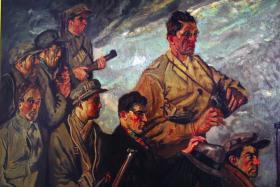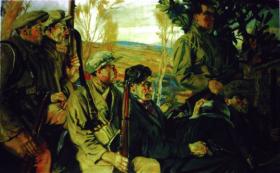Men of the South revisited
Published in 20th Century Social Perspectives, 20th-century / Contemporary History, Features, General, Issue 5 (Sep/Oct 2008), Revolutionary Period 1912-23, Volume 16
This version of Men of the South—almost identical to the original that had languished unfinished in Seán Keating’s Rathfarnham studio until acquired by the Douglas Hyde Collection in 1944—was purchased from the artist by Albert Woods KC and given as a gift to the author’s grandmother, Nora Moylan, who hung it on her sitting-room wall. The work depicts a group of ordinary men in pursuit of an ideal: (front, left to right) Michael Sullivan, John Jones, Roger Kiely, Dan Brown; (back, left to right) Jim O’Riordan, Denis O’Mullane, Jim Cashman and (with binoculars) Seán Moylan. (Moylan family)
The origins of Men of the South may be attributed to a meeting on 25 May 1921 between Albert Wood KC and the recently arrested Seán Moylan, commander of the 2nd North Cork Brigade of the IRA. Moylan was charged by a military court with ‘possession of arms and levying war against the Crown’ and was on trial for his life. Working around the clock, Albert Wood and the instructing solicitor, Barry Sullivan from Mallow, successfully obtained a writ of habeas corpus. The death penalty was commuted to fifteen years’ penal servitude; as events turned out, by August 1921 Moylan was released on foot of the Truce. It was the start of a lifelong friendship. Years later, Moylan remembered that his first impression of Wood was of a man of considerable presence, ‘beautifully dressed and groomed with an accent that seemed to be the quintessence of Oxford’.
Albert Wood was a patron of the arts. His name is noted in Harry Clarke’s visitors’ book along with Thomas Bodkin and others. He introduced Moylan to the world of art, taking him on his first visit to the National Gallery in Dublin. He also introduced him to the young artist Seán Keating, who asked Moylan if he would sit for his portrait wearing the clothes in which he stood trial. The resulting portrait, painted in August 1921, was exhibited at the Royal Hibernian Academy (RHA) the following year. In conversation during these sittings, Keating became familiar with the background and attitude of the fighting men of North Cork. Wood was also a constant visitor to the studio, and the idea came to him that such men and their actions were the raw material for a painting that would capture for posterity the history and spirit of this troubled period. Thus it was in the autumn of 1921 that Moylan set about rounding up a number of his comrades from the IRA’s North Cork Brigade. He arranged for them to travel to Dublin with their guns so that they could sit for Keating in his studio at the Metropolitan School of Art, Kildare Street. Keating’s 1951 memoir of the event recalls that he was working in the college ‘when the porter rushed in breathless and pop-eyed to say the hall is full of men with guns and they’re looking for you!’ ‘Never before or since’, says Keating, ‘have I so impressed a porter as when I answered nonchalantly, all right bring them up.’ That wasn’t the end of it, however: ‘when the shock of the invasion . . . had worn off and the Department of Education had dried its pants’, he was ordered off the premises. He got permission to set up his studio in the Mansion House instead. This arrangement wasn’t very satisfactory, as the light was completely different, but in any case it didn’t last long and Keating found himself ejected again. He returned to Kildare Street and set about making a second version of Men of the South.

Seán Moylan didn’t want to be included in the second, better-known, version of the picture. Fearing that the July 1921 truce might not hold, he thought it unwise to provide the British with a picture of himself. Keating painted the figures one by one and later observed critically that the new picture was not as coherent as the first because of the resulting piecemeal approach. (Crawford Municipal Art Gallery)
A new approach was required in any event, as Seán Moylan didn’t want to be included in this second picture. He believed at the time that the Truce would not hold, and under such circumstances he felt it was unwise that his picture should be available to the British. Keating devised a new composition (p. 43) and, to avoid attracting the attention of the college authorities, he had the men of North Cork come in one by one with their guns well hidden. Later, he observed critically that the new picture was not as coherent as the first because of the resulting piecemeal approach. Keating noted that the original
‘had a quality of verve and dash that would probably have been lost had I been permitted to carry it out in a calm atmosphere so perhaps from the point of view of a historical document it has the qualities more descriptive of the time and circumstances than had it been done out of a mood of reflection and deliberation’.
Men of the South was exhibited at the RHA annual exhibition of 1922. The Irish Independent gave this rousing report of exhibit 134:
‘How fine it is from across the room—breezy and alert and full of air. These are the “boys” surely. How dead and sawdust-stuffed would the average war picture appear beside this thing, so full of life! And it is for sale! I do hope the Cork County Council will join with the Cork Corporation in buying this historical monument; better monument to the “boys” they cannot buy or erect for six times the price. It is only £250 and half that to either of these bodies should be only a trifle.’
Happily, the work was acquired in 1923 by the Gibson Bequest Committee and now hangs in the Crawford Municipal Art Gallery in Cork.
In 1944 Moylan proposed to Michael McDunphy, director of the Bureau of Military History, that the large preparatory work that had languished unfinished in Keating’s Rathfarnham studio for over twenty years be acquired for the Douglas Hyde collection, and this was done. A third, almost identical version, Men of the South, an IRA column 1921 (p. 42), which hung on my grandparents’ sitting-room wall, was purchased from Seán Keating by Albert Wood KC and given as a gift to my grandmother, Nora Moylan.
Some years later, reflecting on the work, Keating noted: ‘It has been said that art originates from emotion recollected in tranquillity’. In painting this picture, he continued, ‘I had many intruding emotions, no need to recollect and no tranquillity . . . one too easily forgets what is too painful to remember’. The work depicts a group of ordinary men in pursuit of an ideal. What they lacked in uniforms and artillery was more than compensated for by their formidable courage and determination. In a letter to Michael McDunphy in January 1951, Keating observed that ‘history belongs to posterity and should be documented in paint as well as print’. He has given this rugged group of men from Duhallow and the environs of North Cork a visual interpretation that has become part of our patriotic identity.
Aideen Carroll is the granddaughter of Seán Moylan.
Further reading:
B. Clifford (ed.), Seán Moylan—in his own words: his memoir of the Irish War of Independence (Aubane, 2003).
















